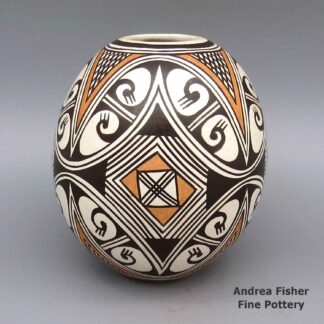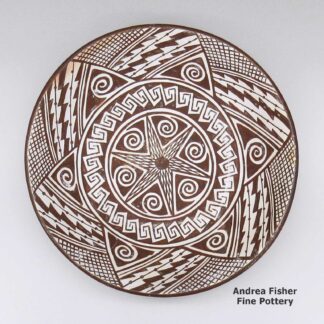Naha, Helen
Helen Naha lived from 1922 to 1993. She was born a Hopi-Tewa in Hano on First Mesa and lived most of her life in the Hano-Polacca-Keams Canyon area.
Helen’s Tewa ancestors had migrated to the Hopi mesas after the 1680 Pueblo Revolt sent the Spanish running from northern Nuevo Mexico. Some say those Tewa ancestors were recruited by the Hopis to protect them should the Spanish ever come back. Others say they were running from the Spanish. Either way, within a couple years of their arrival the Tewa warriors had fought off Ute, Dineh and Apache raiders. Finally, after one particularly fierce battle with Ute raiders, the people of Walpi made a deal with them where they were given land to farm and a location to build their own pueblo.
Since that time, intermarriage between the two groups has produced today’s Hopi, Hopi-Tewa and Tewa, the classification depending on one’s ancestry.
Helen began making pottery when she was in her late teens and continued making pottery almost to the day she died. Her mother-in-law was Paqua Naha (also known as First Frog Woman) and her sister-in-law was Joy Navasie (Second Frog Woman).
Helen said she was mainly a self-taught potter but she did glean a few tips from watching her in-laws make pottery. In the beginning of her career she was mostly using what she learned from Joy Navasie and copying Sikyátki-Revival styles and designs. But she was never happy with that.
She didn’t come into her own until she began developing her own whiteware styles, decorating them with designs she developed on her own, based on pot sherds she’d found in the ruins of Awatovi (an ancient village of mostly Keres-and-Towa-speaking people located on Antelope Mesa, east of First Mesa). Awatovi was destroyed by Hopis from Walpi and other villages in the winter of 1700-1701. The pueblo was burned and it was never rebuilt. But they left behind a massive amount of broken pottery.
Helen was known for producing jars, wedding vases, bowls, vases, cylinders, miniatures and tiles. Over the period of her lifetime she almost singlehandedly revived designs such as the Awatovi star and bat wing patterns. She also had a fondness for feather, water, spiral, Nachwach-clan handshake (the Handshake of Brotherhood), Anasazi black-on-white, sun, rain and bands of connected scroll designs.
Early in her career Helen produced a lot of stark black-on-white Hopi pottery but later in life she crafted significantly more polychrome pieces. Helen taught her son Burel, her daughters Sylvia and Rainy, and her granddaughter Tyra how to make pottery.
Helen usually signed her pieces with a stylized feather hallmark. Her descendants have mostly signed their own pots with a stylized version of that feather and their initial underneath. Today, the Naha and Navasie families are the primary producers of Hopi whiteware, also now known as Walpi Polychrome.
Helen participated in a few shows, earning a First Place ribbon at the New Mexico State Fair in 1973. Pieces of hers are in the permanent collections of the Museum of Northern Arizona in Flagstaff and the Heard Museum in Phoenix. The Southwest Association for American Indian Arts honored Helen by creating the Helen Naha Memorial Award for Excellence in Traditional Hopi Pottery.
Some Exhibits that featured works by Helen
- Elegance from Earth: Hopi Pottery. Heard Museum. Phoenix, Arizona. March 24, 2012 – April 6, 2014
- Home: Native People in the Southwest. Heard Museum. Phoenix, AZ. 2005
- Images, Artists, Styles: Recent Acquisitions from the Heard Museum Collection. Heard Museum North. Scottsdale, AZ. 2001 July 2001 – December 2001
Showing all 2 results
-

Helen Naha, jbho2h116: Polychrome jar with geometric design
$995.00 Add to cart -

Helen Naha, zzho3b553, Bowl with a geometric design on inside, fire clouds on outside
$1,800.00 Add to cart
Showing all 2 results